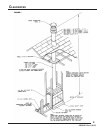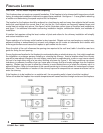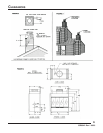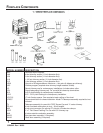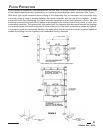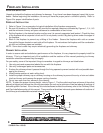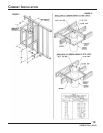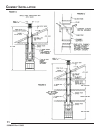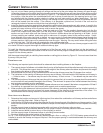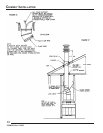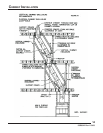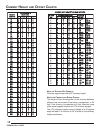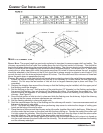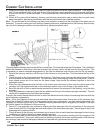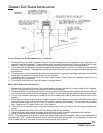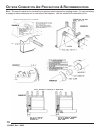
12
53D9042. Rev 1 03/03
1. Lay out, cut and frame openings through all ceilings and the roof at the point where the chimney will pass through.
Unless the chimney is to be offset, the point where the center line of the chimney will pass through the ceiling and roof
can be determined with a plumb line as shown by Figure 16. The fireplace should be located in the planned installa-
tion position. After the center line is established and a nail is driven to mark the point, the opening can be cut if you
are satisfied with the chimney location relative to ceiling and roof joists and/or any other obstructions. The roof
opening center line should be marked by driving a nail through the roof from underneath that will penetrate the roof
and can be located from the rooftop. If the chimney is to penetrate a pitched roof, the hole in the roof must be
rectangular instead of square and should be sized according to Table1.
2. Install the firestop spacer as required from beneath the ceiling unless the space above is attic space. In an attic, the
firestop spacer should be installed at the floor level of the attic. You must have joists or headers on all four sides of the
spacer and use a minimum of four 8-penney nails to secure the spacer.
3. To install the “L” series chimney sections, insert the male end of the flue, the smallest diameter pipe, into the flue
outlet of the fireplace and press down until the snap locks engage. Continue the process, adding the chimney
sections on top of each other until the chimney is at least six inches above the roof opening on all sided. As the
chimney sections are installed, check each joint to make sure it is properly locked to the previous section. If addi-
tional strength of the outer pipe joints is desired, you may use two or three sheet metal screws placed through the
area where the outer pipes overlap one another. To install these screws, drill a 1/8-inch diameter hole through the
chimney sections, taking care not to penetrate the inner flue pipe. Warning: Be very careful when drilling the holes
into the outer pipe. The drill must not penetrate the inner stainless steel pipe.
NOTE: If you intend to have a total fireplace installation of more that 30 feet you must use chimney support model LCS
at or below 30 feet to support the weight of additional chimney pipe.
To install the chimney support, place the crimped end of the flue and outlet air duct portions into the last section of
chimney pipe. Push down until the outside or inlet air duct of the chimney support overlaps and snap locks the chimney
support into the chimney section.
Nail the support straps tightly to a building frame member or ceiling joist as shown by Figure 13. You must use at least two
8-penney nails per strap.
ELBOW INSTALLATION
The following are important points that should be observed when installing elbows on the fireplace:
1. The support straps of all elbows not installed directly on top of the fireplace should be nailed securely to the surrounding
structure. This allows the support strap to carry the weight of the chimney above the elbow and prevents this weight
from breaking the elbow or chimney sections apart.
2. Elbows should not be used in any combination that inclines the chimney more than 30 degrees from vertical.
3. The limitations on the quantity of elbows per chimney are as follows: If the total height of the fireplace and chimney is
— 24 feet or more — two elbows may be used in the chimney. 30 feet or more — four elbows may be used in the
chimney.
4. The inclined portions of chimneys that pass through living spaces likely to be used for storage should be enclosed to
avoid contact with and possible damage to the chimney. The minimum air space of two inches between the chimney
and enclosing materials must be maintained.
5. The length of the inclined portion of chimney between elbows must not exceed 6 feet when unsupported or 20 feet if
the chimney is supported at six-foot intervals with support such as metal support straps.
6. When enclosing the elbows and inclined portions of the chimney, enclosing materials must be installed vertically to
maintain the required two-inch minimum air space clearance to the chimney at the extremities of the offset. It is
recommended that enclosing material not follow the inclined portions of the chimney.
OFFSET INSTALLATION SEQUENCE
1. Determine the location and amount of offset required, then select the combinations of chimney sections and elbows
required from the offset chart. Refer to Page 18.
2. Install the first LE30 elbow by placing the extended flue into the mating part of the fireplace or chimney section. Push
down until the outside or inlet air duct of the elbow overlaps and the snaps lock the elbow into the fireplace or chimney
section.
3. Nail the support straps to the framing member with a minimum of two 8-penny nails per strap.
4. Install the sections of pipe between elbows until the proper number of chimney sections have been installed.
5. Install the second elbow to return the run of the chimney to vertical.
6. Nail the support straps of the second elbow to a building frame member.
7. Continue installing the vertical portion of the chimney.
NOTE: If the inclined portion of the chimney passes through a floor or ceiling, an LF-FS-30 firestop spacer should be
installed to provide the firestop and support required. Be sure proper spacing in maintained between the chimney and
combustibles.
CHIMNEY INSTALLATION



